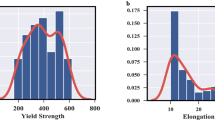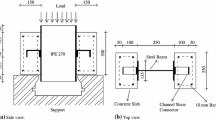Abstract
Material problem is one of the key issues for the realization of fusion energy. Reduced Activation Ferritic/Martensitic steels have been considered to be the primary candidate structural material for fusion DEMO reactors and the first fusion power plants. China low activation martensitic steel (CLAM) has been chosen as the primary structure material in the designs of FDS series PbLi blankets for fusion reactors, CN helium cooled ceramic breeder test blanket module for ITER, liquid blanket of China fusion engineering test reactor (CFETR). In this work, optimization of CLAM steel composition was performed based on extreme learning machine method. The results showed that CLAM steel with Ta content of 0.18–0.20 % had better tensile property at the temperature of 350–550 °C, which provided references for the optimization of CLAM steel composition.





Similar content being viewed by others
References
F. Abe, T. Noda, H. Araki et al., Alloy composition selection for improving strength and toughness of reduced activation 9Cr–W steels. J. Nucl. Mater. 179, 663–666 (1991)
R.L. Klueh, D.J. Alexander, M. Rieth, The effect of tantalum on the mechanical properties of a 9Cr–2W–0.25V–0.07Ta–0.1C steel. J. Nucl. Mater. 273, 146–154 (1999)
R.L. Klueh, D.J. Alexander, M.A. Sokolov, Effect of chromium, tungsten, tantalum, and boron on mechanical properties of 5–9Cr–WVTaB steels. J. Nucl. Mater. 304, 139–152 (2002)
M. Tamura, H. Hayakawa, M. Tanimura et al., Development of potential low activation ferritic and austenitic steels. J. Nucl. Mater. 141, 1067–1073 (1986)
R. Lindau, A. Moslang, M. Rieth et al., Present development status of EUROFER and ODS -EUROFER for application in blanket concepts. Fusion Eng. Des. 75–79, 989–996 (2005)
T. Hiroyasu, S. Kiyoyuki, H. Takanori, et al., Status and key issues of reduced activation martensitic steels as the structural materials of ITER test blanket module and beyond, in Proceedings of the 21st IAEA Conference on Fusion Energy (2006)
K. Laha, S. Saroja, A. Moitra, et al., Development of India-specific RAFM steel through optimization of tungsten and tantalum contents for better combination of impact, tensile, low cycle fatigue and creep properties. J. Nucl. Concept. Des. Mater. 439, 41–50 (2013)
Y. Wu, F.D.S. Team, Conceptual design activities of FDS series fusion power plants in China. Fusion Eng. Des. 81(23–24), 2713–2718 (2006)
L. Qiu, Y. Wu, B. Xiao et al., A low aspect ratio tokamak transmutation system. Nucl. Fusion 40, 629–633 (2000)
Y. Wu, J. Qian, J. Yu, The Fusion-driven hybrid system and its material selection. J. Nucl. Mater. 307–311, 1629–1636 (2002)
Y. Wu, J. Jiang, M. Wang et al., A fusion-driven subcritical system concept based on viable technologies. Nucl. Fusion 51(10), 103036 (2011)
Y. Wu, F.D.S. Team, Conceptual design of the China fusion power plant FDS-II. Fusion Eng. Des. 83(10–12), 1683–1689 (2008)
Y. Wu, F.D.S. Team, Fusion-based hydrogen production reactor and its material selection. J. Nucl. Mater. 386–388, 122–126 (2009)
Q. Huang, C. Li, Y. Li et al., Progress in development of China low activation martensitic steel for fusion application. J. Nucl. Mater. 367–370, 142–146 (2007)
Q. Huang, S. Gao, Z. Zhu et al., Progress in compatibility experiments on lithium-lead with candidate structural materials for fusion in China. Fusion Eng. Des. 84, 242–246 (2009)
Q. Huang, Y. Wu, J. Li et al., Status and strategy of fusion materials development in China. J. Nucl. Mater. 386–388, 400–404 (2009)
Q. Huang, N. Baluc, Y. Dai et al., Recent progress of R&D activities on reduced activation ferritic/martensitic steels. J. Nucl. Mater. 442(1–3), S2–S8 (2013)
Q. Huang, C. Li, Q. Wu et al., Progress in development of CLAM steel and fabrication of small TBM in China. J. Nucl. Mater. 417, 85–88 (2011)
Y. Li, Q. Huang, Y. Wu et al., Mechanical properties and microstructures of China low activation martensitic steel compared with JLF-1. J. Nucl. Mater. 367–370, 117–121 (2007)
Y. Wu, Q. Huang, Z. Zhu et al., R&D of dragon series lithium lead loops for material and blanket technology testing. Fusion Sci. Technol. 62–1, 272–275 (2012)
Q. Huang, J. Li, Y. Chen, Study of irradiation effects in China low activation martensitic steel CLAM. J. Nucl. Mater. 329, 268–272 (2004)
S.K. Sarkar, J.K.Chakravartty Sinha et al., Artificial neural network modeling of in-reactor diametral creep of Zr2.5%Nb pressure tubes of Indian PHWRs. Ann. Nucl. Energy 69, 246–251 (2014)
A. Bahrami, S.H. Mousavi, Anijdan, A. Ekrami. Prediction of mechanical properties of DP steels using neural network model. J. Alloys Compd. 392, 177–182 (2005)
A.M. Rashidi, A.R. Eivani, A. Amadeh, Application of artificial neural networks to predict the grain size of nano-crystalline nickel coatings. Comput. Mater. Sci. 45, 499–504 (2009)
Z.Y. Liu, W.-D. Wang, W. Gao, Prediction of the mechanical properties of hot-rolled C–Mn using artificial neural networks steels. J. Mater. Process. Technol. 57, 332–336 (1996)
G.B. Huang, Q.Y. Zhu, C.K. Siew, Extreme learning machine: theory and applications. Neurocomputing 70(1), 489 (2006)
G.B. Huang, Q.Y. Zhu, C.K. Siew, Extreme learning machine: a new learning scheme of feedforward neural networks, in 2004 IEEE International Joint Conference on Neural Networks, 2004. Proceedings. vol. 2 (2004), pp. 985–990
G.-B. Huang, Learning capability and storage capacity of two-hidden-layer feedforward networks. IEEE Trans. Neural Netw. 14(2), 274–281 (2003)
D. Serre, Matrices: Theory and Applications (Springer, New York, 2002)
P.L. Bartlett, The sample complexity of pattern classification with neural networks: the size of the weights is more important than the size of the network. IEEE Trans. Inf. Theory 44(2), 525–536 (1998)
Q. Huang, Research on China Low Activation Martensitic Steel for Fusion Application (Hefei Institutes of Physical Science, Chinese Academy of Sciences, Hefei, 2006), pp. 1–79
Acknowledgments
The authors would like to show their great appreciation to other members in FDS Team for their supports and contributions to this research. This work was supported by the ITER 973 Program (2013GB108005), the Special Program for Informatization of the Chinese Academy of Sciences (XXH12504-1-09) and the young foundation of Huaibei Normal University (2014xq013).
Author information
Authors and Affiliations
Corresponding author
Rights and permissions
About this article
Cite this article
Shen, L., Zhai, X., Chen, C. et al. A Preliminary Study on the CLAM Steel Composition Optimization Based on Extreme Learning Machine. J Fusion Energ 34, 1071–1076 (2015). https://doi.org/10.1007/s10894-015-9912-9
Published:
Issue Date:
DOI: https://doi.org/10.1007/s10894-015-9912-9




